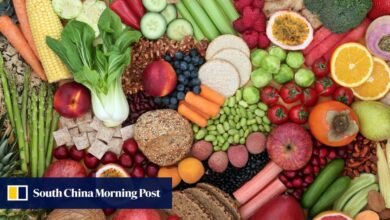Do SNAP Food Restrictions Help Health, or Punish Poor People?

This text seems within the August 2025 difficulty of The American Prospect journal. Subscribe here.
Images by Gonzalo Guzman
GARY, INDIANA – Driving via Northwest Indiana feels a bit like going again in time. Winding roads, barns, and plush inexperienced fields within the rural farm communities give approach to hulking metal mills, tall smokestacks, large warehouses, and artwork deco film palaces as you hit Gary. Look somewhat nearer, although, and the ’50s ideally suited of nation life main into the large metropolis turns into hazier. The film palace, residence of the 2002 Miss USA pageant (run by an impresario named Donald Trump), is boarded up, the home windows damaged. The roles, or at the least most of them, are gone, together with most of the individuals who labored at them.
A lot of these on this area depend on authorities support in a roundabout way, whether or not or not it’s farm subsidies or social security web advantages like Medicaid and the Supplemental Vitamin Help Program, or SNAP. In Indiana, 1 out of each 11 residents receives SNAP advantages. The state’s staunchly Republican authorities has made a follow of canceling or defunding safety-net applications, however this 12 months there was a twist. In April, Gov. Mike Braun allied himself with Well being and Human Providers Secretary Robert F. Kennedy Jr.’s Make America Wholesome Once more agenda, signing 9 govt orders for the Make Indiana Wholesome Once more initiative.
A type of govt orders empowered the state to submit a waiver request to the U.S. Division of Agriculture (USDA), asking for authorization to limit what low-income Hoosiers who obtain SNAP advantages should buy. In Could, USDA Secretary Brooke Rollins permitted the waiver. Beginning in January, SNAP recipients in Indiana gained’t have the ability to use SNAP to purchase sweet or sugary drinks like soda and a few juices.
To this point, Indiana is certainly one of six states which have been permitted by the USDA to ban sugary meals from SNAP, however specialists say that they’re monitoring at the least eight others which may observe go well with. Earlier this 12 months, eight Home Republicans introduced a bill that will do the identical factor.
The transfer is a sophisticated one, as are so most of the insurance policies that make up the MAHA agenda. It’s true that sugary meals can have quasi-addictive properties and put customers in danger for power diseases like diabetes. It’s true that People, particularly low-income Americans, have excessive charges of those food-related power diseases. Ideally, we might have a meals system that prioritizes recent vegetables and fruit over sweet bars and sodas.
However SNAP advocates say we don’t reside in that world, and additional limiting what low-income People should purchase gained’t assist get us any nearer. And as an alternative of simply proscribing folks to wholesome meals, the strikes in pink states may limit folks from discovering someplace to make use of their SNAP advantages altogether.
It’s additionally particularly tough to belief Braun, RFK Jr., and different politicians aligned with the Trump administration, after half a 12 months of relentless cuts to the identical social security web applications which are designed to take care of and promote People’ well being. The One Huge Lovely Invoice Act, Trump’s landmark spending bundle handed in July, cuts $186 billion from SNAP. The Heart on Price range and Coverage Priorities estimates that as many as 5 million folks could lose SNAP benefits. In the identical invoice, Republicans plan to chop practically $1 trillion from Medicaid, a transfer that will make well being care unaffordable for a lot of of those similar People and decimate rural hospital methods.
Braun has achieved his fair proportion of cuts in Indiana, too. After only one 12 months of collaborating within the federal authorities’s SUN Bucks program, which provides low-income households with kids $120 to purchase groceries in the course of the summer time, Braun declined to renew the program for this summer time. An announcement from Indiana’s Household and Social Providers Administration didn’t provide a transparent rationalization, simply saying that “essential groundwork had not been accomplished” to run this system. The cancellation will depart 700,000 Indiana kids hungrier than they have been final summer time.
Are these the individuals who will make Indiana, and America, wholesome once more? Or does this fervor to ban sugary meals from SNAP have an ulterior motive?
AS I DROVE TO THE FARMHOUSE THAT SERVES as the bottom of operations for the Northwest Indiana Meals Council, I used to be struck by the abundance of meals that I noticed—fields overflowing with rows of corn, small patches of leafy greens, non-public greenhouses right here and there. However once I spoke to Anne Massie and Becca Tuholski, two farmers and leaders of the Council, they instructed me that the loads I noticed didn’t translate to the tables of odd folks within the area.
The Council was fashioned in 2015 to deal with each the financial safety of native farmers and the meals insecurity of oldsters within the area. In line with Massie, the group’s president, and Tuholski, the native meals entry coordinator, the 2 points are intently linked.
“You’ll be able to drive for miles and miles and miles and simply be surrounded by corn and soybeans, however there’s not a grocery retailer in sight,” stated Tuholski. “We’re surrounded by meals, however it’s not meals for us.”
These corn and soy crops are sometimes processed into animal feed or changed into substances like corn syrup, which then is used to make the identical low-cost, candy, ultra-processed meals that find yourself on corner-store cabinets in Gary’s meals deserts: bottles of Coke, Hershey’s bars, tubs of ice cream.
“Once we are simply subsidizing commodity crops which are changed into sweeteners and processed meals, these are … typically the one choices in communities the place shelf-stable meals is all that they’ve entry to,” stated Massie. “We wish to see extra effort on making wholesome meals extra inexpensive.”
As a substitute of simply proscribing folks to wholesome meals, pink states may limit folks from discovering someplace to make use of their SNAP advantages altogether.
Earlier than reaching Gary, I ended in East Chicago, Indiana, a city of 25,000 the place 1 / 4 of the inhabitants lives beneath the poverty line. Till 1985, the realm was the positioning of a number of lead smelting amenities; research have discovered elevated levels of lead and arsenic in East Chicago’s soil, in addition to excessive lead ranges in some residents’ water. Regardless of the environmental hazards left behind by business, the city is gorgeous, with red-brick storefronts, foxgloves blooming in entrance yards, and flower pots hanging from lampposts.
The closest main grocery retailer, an Aldi, is within the subsequent city over, so many East Chicago residents depend on native mom-and-pop grocers. One such store is Fuerte Meat Market, a Hispanic meals store on one of many essential streets. I spoke to the shop supervisor, Bartolo Fuerte, who instructed me that 60 to 65 % of his clients pay for his or her groceries with SNAP, particularly between the fifth and twenty third of the month, when Indiana sends out SNAP funds. Fuerte stated that clients who use SNAP sometimes purchase quite a lot of meals: meat from his butcher counter, produce, but in addition soda (“pop,” to many within the area) and sweet.
As for Indiana’s ban on shopping for sugary drinks and sweet with SNAP {dollars}, Fuerte was a supporter. “It’s unhealthy for my enterprise, however it’s good for folks,” he stated. “Soda is like consuming liquor, virtually.”
The comparability to alcohol is one which many proponents of the plan echo. SNAP has never allowed the purchase of alcohol, tobacco, or hashish merchandise. Some, like Laura Schmidt, a professor on the Institute for Well being Coverage Research on the College of California San Francisco Faculty of Drugs, argue that soda needs to be in that very same class. Schmidt wrote in an op-ed that ultra-processed and sugary foods share the addictive qualities of alcohol and tobacco. They have been designed to get customers hooked; the truth is, many meals producers like Kraft and Common Meals have been at one time owned by the identical tobacco firms that received generations of People hooked on cigarettes. To guard customers from company greed, she argues, the federal government ought to step in.
Fuerte predicts that the ban will have an effect on his backside line however once more emphasised that the group’s well being is his precedence: “No matter the federal government does for the folks, for his or her well being, I’ve to help it.”
BUT EXPERTS SAY THAT THE BAN COULD MAKE meals insecurity worse by burdening small grocers with new administrative protocols and decrease revenues. “We’re speaking in regards to the mom-and-pop retailers who’re the one entity standing between 90 miles and meals,” stated Gina Plata-Nino, a meals advocate with the Meals Analysis & Motion Heart. She predicts that some retailers gained’t wish to replace their methods to accommodate the SNAP adjustments and should cease accepting SNAP advantages altogether. “It’s extremely costly. It’s proscribing. Costly for the states to determine, costly for the retailers, and the end result will probably be that [fewer grocers] will wish to be on this system,” she defined.
The USDA has blocked SNAP cuts on this foundation earlier than. In 2010, New York Metropolis beneath then-Mayor Michael Bloomberg tried to implement a ban on sugary drinks for SNAP recipients. The USDA denied New York City’s request, writing that it will be too complicated for retailers to implement. “The proposal lacks a transparent and sensible means to find out product eligibility, which is important to keep away from retailer confusion at point-of-sale and stigma for affected shoppers,” the USDA’s letter stated.
These points, unsolved and prohibitive in 2010, stay immediately. Among the many six states with permitted waivers, there are restrictions on “soda,” “smooth drinks,” “power drinks,” “sweet,” and easily “unhealthy drinks.” The descriptions aren’t constant, and on the federal degree there is no such thing as a definitive USDA definition of a “sugary” meals. This leaves all types of issues as much as interpretation. Do sports activities drinks like Gatorade depend as “unhealthy drinks”? What about power drinks or vitamin waters? At what level does fruit juice transfer from being wholesome to unhealthy? Ought to fruit roll-ups be thought-about sweet? What about chocolate-covered almonds? What number of grams of added sugar makes one thing “sugary”? Although some states have gone into extra element, most haven’t, leaving these questions unanswered.
With out clear definitions and straightforward point-of-sale protocols, retailers might be compelled to police every buyer’s buy, probably in entrance of different clients. For some SNAP recipients, the advantages already carry sufficient stigma. “A part of the rationale that folks don’t wish to be on SNAP is due to the stigmatizing boundaries and judgments,” stated Plata-Nino. “It’s the rationale why folks store at midnight.”
FUERTE MEAT MARKET ALSO SERVES HOT FOOD, with well-priced tacos, tortas, and burritos in a nook by the entrance registers. However SNAP recipients can’t use their advantages on sizzling ready meals, together with merchandise like rotisserie chickens. Arkansas Republican Gov. Sarah Huckabee Sanders, who additionally banned sugary meals from her state’s SNAP program, stated when she introduced the ban: “Proper now you need to use meals stamps to purchase a smooth drink or sweet bar from a fuel station, however you possibly can’t use them to purchase an Arkansas-raised sizzling rotisserie hen from a grocery retailer. That’s the definition of loopy.”
To listen to Sanders inform it, the addition of rotisserie hen would assist counteract the subtraction of sugary meals from SNAP eligibility. However sizzling meals like rotisserie hen weren’t mentioned in the waiver request Sanders despatched to the USDA, and USDA Secretary Brooke Rollins only approved the cuts to sugary foods. When the waiver takes impact in January 2026, Arkansas residents nonetheless gained’t have the ability to purchase sizzling meals, regardless of how Sanders offered it.
SNAP advocates like Joelle Johnson of the Heart for Science within the Public Curiosity say that this sample of solely subtracting from SNAP reasonably than including to it betrays Republicans’ true intentions. “If the administration really wished to realize these issues—lowering well being disparities and lowering diet-related power illness—then we needs to be seeing language round defending SNAP advantages, rising SNAP advantages, ensuring that folks can afford to purchase groceries,” she stated.
MOST OF GARY IS CLASSIFIED AS A FOOD DESERT by the USDA. Each few miles, there’s a Household Greenback or small nook retailer, however few with recent fruit or produce. I ended in quite a few these small grocers, attempting to get a way for the group’s choices. In a single, fifth Plaza Meals Mart & Magnificence Provide, the one produce choices have been a watermelon, two avocados, and two lemons sitting on the dirty backside shelf of a fridge.
Those that reside in Gary know this already. I sat down with native advocates Carl Weatherspoon Jr., the vice chair of the Gary Meals Council, and Tiara Williams, who helps run a block beautification initiative for town. Each Weatherspoon and Williams have been born and raised within the metropolis, and we spent a good chunk of our dialog evaluating native grocery choices.
“So that you’ll have a grocery retailer right here, and you may see that that grocery retailer shouldn’t be providing recent objects, and it smells like a pig was slaughtered six days in the past proper right here on the register. Now why is it that means right here, however not whenever you go to [nearby towns] Merrillville or Schererville or Crown Level?” requested Williams wryly. “There’s a typical denominator, however I can’t fairly put my finger on it.”
Williams was not so subtly referring to race, and its interwoven relationship with poverty. Within the 2020 census, round 80 percent of Gary’s residents have been Black, in comparison with 50 percent in Merrillville and simply 7 percent in Crown Point (racial census knowledge wasn’t out there for Schererville in 2020). In Gary, 27 percent of Black residents are meals insecure.
“We’re focusing on and beating up a really weak inhabitants.” – Gina Plata-Nino, Meals Analysis & Motion Heart
After a long time of being left behind, group activists and employees in Gary, like Weatherspoon and Williams, have lengthy deserted the hope that the federal government will act in the very best curiosity of their well being, opting as an alternative to take issues into their very own fingers. The three of us sat perched on stumps in Gary’s Mystical Farms, a metropolis grant–funded backyard constructed on a vacant lot in a residential neighborhood. We ate calendula flowers (spicy, then candy), peppermint leaves (cooling), and hibiscus tea that helped mitigate the 90-degree warmth and thick humidity. Throughout the hour we sat there, neighbors stopped by to talk; it was clear that the backyard was a neighborhood gathering place along with a spot the place residents may harvest free, wholesome vegetables and fruit.
“My grandfather had a backyard. His grandmother had a backyard,” Williams instructed me, pointing to Weatherspoon. “And that has to do with plenty of our folks coming from the South and understanding that you just do have to backyard. You want to be liable for your individual meals, and that’s what they did.”
Williams’s grandfather got here to Gary from the South as a part of the Nice Migration, leaving life as a sharecropper who picked cotton and was stored continuously in debt by landlords. He introduced with him a dedication to rising his personal meals and, in keeping with Williams, was identified to drop off greens and tomatoes to his neighbors. “It’s an artwork that has been misplaced, sadly, however via issues like group gardens, the place persons are prepared to teach, the group feels comfy to come back again,” she stated.
The hope is that, by constructing a connection to the land, Gary residents will regain sovereignty over their meals ecosystem, eliminating reliance on nook shops and SNAP guidelines. They’re already seeing progress. “Mr. John throughout the road, he’ll come over right here and get a cucumber or tomato,” stated Weatherspoon. “He from Mississippi, he has a backyard. Miss Betty and Tia, her granddaughter, they’ll stroll down the road and make some cha cha with our sizzling peppers. It’s scrumptious. They don’t go to the grocery retailer.”
Once I requested Williams and Weatherspoon what they thought in regards to the sugary meals ban, I wasn’t fairly positive what they’d say. They’re each so deeply linked to the meals they develop and eat, and adamant about the advantages of consuming healthfully. However they each instantly noticed the ban as paternalism from individuals who don’t have the very best curiosity of low-income Hoosiers at coronary heart.
“What do I take into consideration the federal government regulating what folks eat when there may be nothing actually right here to exchange it? Properly, that’s an injustice in itself,” Williams stated. “When you’re not going to deal with these sorts of points, I believe punishing the one that receives the SNAP advantages shouldn’t be the best way.”
BACK IN EAST CHICAGO, I SPOKE TO CECE CRUZ, the proprietor of Broadway Meals Store, a hole-in-the-wall grocer simply two blocks away from Fuerte Meat Market. Exterior the store’s entrance door, an AC unit dripped water right into a bucket, working laborious towards the summer time warmth.
Cruz’s stock is generally dry items, like beans, pasta, and bread. There’s a small, refrigerated soda part and a good smaller produce part. Cruz, who has owned the store for 47 years, instructed me that some 80 % of her clients use SNAP. A lot of them are single moms, she stated: “They battle via the month as soon as they get their meals stamps and purchase what they’ll.” She usually overhears their kids asking for sweet bars or ice cream. “That’s their deal with,” she stated. “So that you’re going to simply take their deal with away?”
Although she acknowledged that the ban would probably have an effect on her income, she wasn’t terribly fearful. She is aware of that her clients will nonetheless want to purchase fundamentals like bread and milk and, apart from, she feels powerless to vary the coverage: “We now have to go along with it. We now have no different alternative.”
Like Cruz, Plata-Nino is worried that the coverage beats up on those that want probably the most assist, like single moms attempting to feed their kids. “We’re focusing on and beating up at a really weak inhabitants. [Sugar consumption] is a matter for all of America,” she stated. “Why are you focusing on a inhabitants that doesn’t have a seat on Capitol Hill?”
It’s true that sugar consumption shouldn’t be distinctive to SNAP recipients. Knowledge about what SNAP recipients eat is notoriously tough to gather; buying knowledge is non-public to grocers. The definitive study on how SNAP recipients eat used knowledge from 2011 and located that “there have been no main variations within the expenditure patterns of SNAP and non-SNAP households.” SNAP recipients spent most of their cash on meat, poultry, and seafood, and the subsequent largest class was sweetened drinks. For non-SNAP customers, sweetened drinks have been the fifth-largest class. SNAP households spend 9 % of their advantages on sweetened drinks, and non-SNAP households spend 7 %.
Different research have analyzed how a sugary drink ban may change diabetes and weight problems charges. One simulation found that the prevalence of Sort 2 diabetes amongst SNAP recipients may decline by 240,000 folks over ten years if the ban have been carried out. And sugar consumption is clearly linked to a number of well being issues apart from Sort 2 diabetes, like coronary heart illness, cavities, and gout.
The SNAP advocates I spoke to don’t deny that extra sugar consumption is dangerous; they only disagree that bans like Indiana’s are the fitting strategy to repair it. “There’s a proper approach to do it and a fallacious approach to do it,” Johnson stated. “I’d like to see waiver requests from states the place they’re proposing to design a analysis pilot that pairs a fruit and vegetable incentive with a sugary beverage disincentive.”
Schmidt, the us sugar researcher, additionally proposed using savings from the sugar cuts to fund fruit and vegetable incentives, tackling the affordability disaster that retains many SNAP recipients from consuming more healthy. Indiana began their fruit and vegetable incentive program, Double Up, in 2020, permitting SNAP recipients to get an additional greenback for each greenback they spend on produce at some retailers and farmers markets, as much as $20 per day. I requested Braun’s workplace whether or not they deliberate to develop Double Up alongside their latest cuts, however they declined to reply. Double Up wasn’t talked about in any of Braun’s Make Indiana Wholesome Once more executive orders or press conferences.
Massie, the farmer and Meals Council chief, desires farmers to promote extra produce and Hoosiers to eat extra produce—she’s devoted her profession to it, in spite of everything. However after months of nothing however cuts from each the Trump administration and the state, she’s misplaced all belief in Indiana to behave in the very best curiosity of the group.
She described how the Council had just lately made main headway in supporting farmers and low-income residents. The Council had administered the Native Meals for Faculties Program and the Native Meals Buying Help Program, each of which have been USDA grant–funded. The initiatives linked Indiana farmers to lower-income residents via their colleges and meals banks, elevating income for farmers and offering diet to group members.
The Native Meals for Faculties Program had introduced $1.4 million in income for native farmers over simply two years. However on March 10, Massie and Tuholski received the information that each applications had been slashed by the federal authorities. Farmers discovered abruptly. Some had already bought further supplies to organize for the elevated demand from the applications.
From Anne’s entrance porch, we appeared out over the neighboring farms and her personal greenhouses, which had simply began to yield the season’s first peppers and tomatoes. She appeared offended, or unhappy, in all probability each.
“What’s the proactive facet of Make America Wholesome Once more? What’s the proactive facet of Make Indiana Wholesome Once more?” she questioned. “As a result of all we’re seeing are cuts and rollbacks.”
2025-07-30 10:17:00





